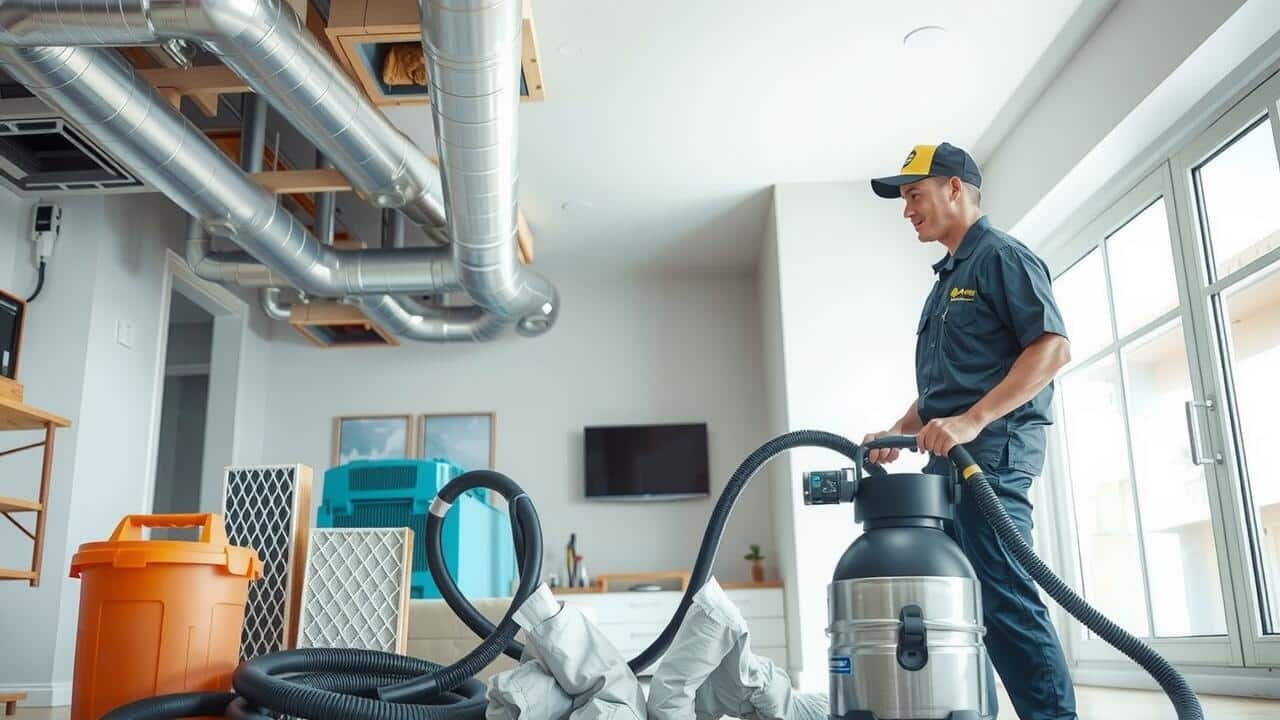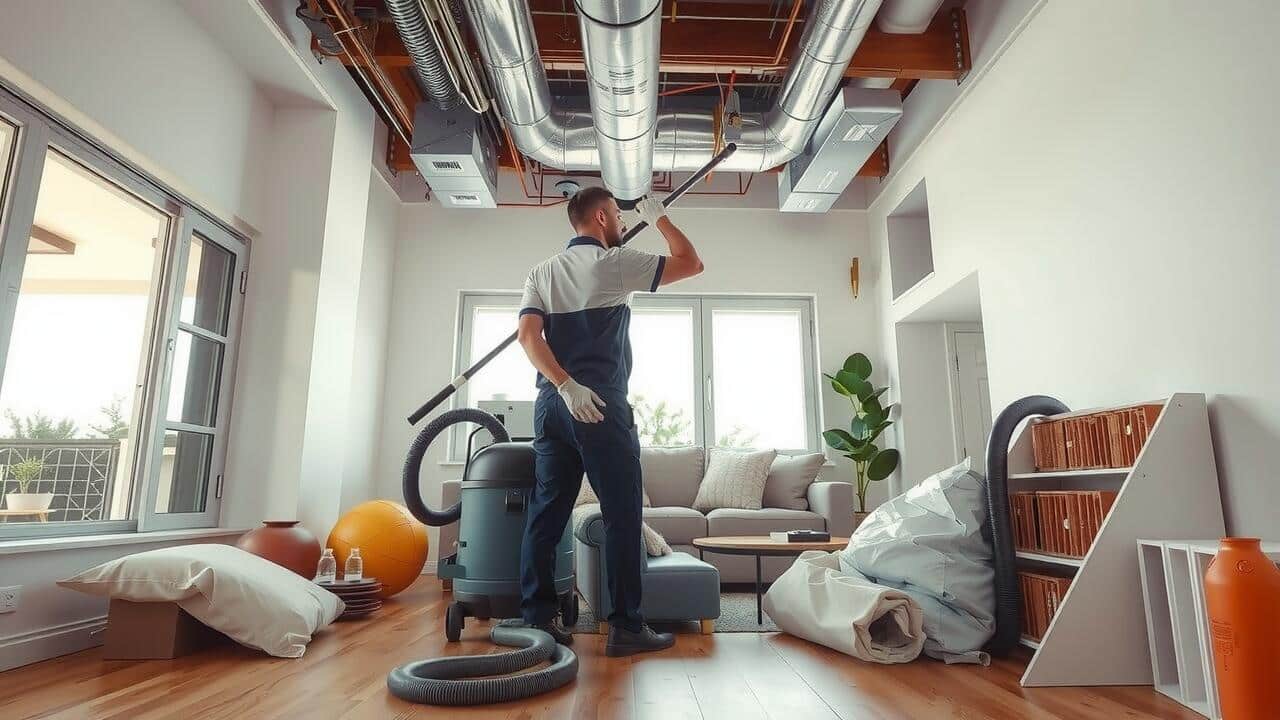
At Express Air Duct Cleaning San Antonio, our Air Duct Sanitizing service is designed to enhance the quality of your indoor air and promote a healthier living environment. Using advanced sanitizing techniques and eco-friendly products, we meticulously clean and disinfect your air duct system, effectively eliminating allergens, bacteria, and other harmful contaminants that can accumulate over time. Our trained professionals ensure that every corner of your ductwork is treated, leaving your home with fresher, cleaner air that you can breathe easily. With our commitment to quality and customer satisfaction, you can trust us to help you maintain a safe and comfortable space for you and your family.
Choosing the Right Sanitization Products
Selecting appropriate sanitization products for air duct cleaning is crucial for maintaining a healthy indoor environment. With various options available, homeowners should consider both chemical and natural disinfectants. Chemical sanitizers often contain biocides and are designed to eliminate microbes, bacteria, and viruses that accumulate in ductwork. It is essential to choose EPA-registered products to ensure safety and efficacy. On the other hand, natural alternatives can offer less harsh solutions while still addressing contaminants and odors. These may include plant-based cleaners that target dirt and allergenic particles without compromising indoor air quality.
In addition to understanding different product types, it’s vital to factor in the specific characteristics of your HVAC system and ductwork. Materials such as fiberglass and insulation may influence product selection; some cleaners could cause damage or worsen existing issues like mold growth. Technicians often recommend using specialized disinfectants that are effective yet safe for specific types of duct materials. Investing time to research and choose the right sanitization products contributes significantly to the overall effectiveness of the air duct cleaning process and the long-term health benefits of a well-maintained HVAC system.
Understanding Chemical and Natural Options
When considering air duct sanitization, the choice between chemical and natural options becomes crucial. Chemical sanitizers often contain strong compounds designed to eliminate harmful bacteria, pathogens, and other pollutants that accumulate in air ducts. Some of these products are effective in addressing serious issues like infestations or severe odors. However, consumers must be cautious, as certain chemical compounds can have varying levels of toxicity, impacting both health and air quality. For example, ozone generators are popular for their ability to neutralize odors but may pose health risks if not used properly.
Natural alternatives also merit attention, especially for those sensitive to chemicals or looking for environmentally friendly solutions. Products that utilize plant-based ingredients or essential oils can provide effective sanitization without the harsh side effects associated with synthetic chemicals. These options may involve using UV lights, which help reduce microbial growth, or steam cleaning methods that rely on high temperatures to sanitize air ducts thoroughly. Consumers in Central Florida can assess their needs and priorities based on their specific circumstances, such as the presence of pets, water damage, or other maintenance issues that could affect air quality and overall health.
Costs Associated with Duct Sanitizing
The costs associated with duct sanitizing can vary significantly based on a range of factors. Homeowners should consider the size of the air duct system, accessibility of the ducts, and the specific methods employed during the sanitization process. Companies may use different approaches, from vacuuming and brushing to applying high-level disinfectants. The materials used, whether chemical or natural, can influence overall pricing as well, particularly if specialized products such as sporicidal sprays or fogging techniques are involved.
In addition to the direct costs of materials, the expertise and qualifications of the technicians performing the service can also impact the price. A team with specialized training in HVAC systems and duct cleaning may charge more due to their knowledge and skill level. Factors like local regulations, which may affect the use of certain chemical products, also play a role in determining the final price. Homeowners should consider obtaining multiple quotes and inquiring about the specific services included in each estimate to ensure they are making an informed decision.
Factors Influencing Service Pricing
The pricing for air duct sanitizing services can vary significantly based on several key factors. The size of the home plays a critical role; larger properties typically require more time and resources for thorough cleaning. The complexity of the duct system also impacts pricing, especially if there are multiple turns, branches, or areas difficult to access. Additional services such as antimicrobial treatment or the installation of UV sanitizers can raise costs as well, due to the specialized equipment and special expertise needed for proper application.
Geographical location influences pricing as well, with urban areas generally experiencing higher service costs than rural settings. The experience and qualifications of the technicians performing the service contribute to the overall cost too. Companies with well-trained staff or those certified to work with heating and cooling systems may charge more due to their advanced knowledge and skills. Furthermore, the level of indoor air pollution or the presence of mold growths may require more intensive remediation, affecting how much homeowners can expect to pay for effective sanitization.
The Role of Trained Technicians
Trained technicians play a critical role in air duct sanitizing, ensuring a thorough understanding of the methodologies involved. Their education and expertise enable them to navigate the complexities of indoor air quality (IAQ) issues effectively. These professionals are equipped to identify potential irritants and harmful contaminants like bacteria, mold, and allergens that can accumulate in duct systems over time. They are knowledgeable about the appropriate use of various sanitization products, whether chemical or natural, which can help in minimizing harmful effects on occupants’ health.
When performing sanitization, technicians follow strict guidelines set by organizations like the United States Environmental Protection Agency (EPA) and the American Society for Testing and Materials (ASTM). Their training allows them to handle corrosive substances safely, minimizing risks of allergic reactions or other health issues related to improper sanitization methods. The technicians inspect all components of the system, from the filter to the blower, ensuring a comprehensive approach that enhances hygiene and indoor air quality while being mindful of energy efficiency standards.
Qualifications and Expertise
Trained technicians bring a wealth of knowledge and skills to air duct sanitizing services. Their qualifications often include certifications that demonstrate a thorough understanding of ductwork systems, relevant safety protocols, and the proper use of cleaning products. Familiarity with both chemical and natural sanitization options ensures they can make informed choices tailored to specific needs, minimizing the risk of irritation or harmful exposure. The expertise of these professionals includes recognizing signs of mold or other contaminants that may not be visible to the naked eye, ensuring a comprehensive approach to maintaining indoor air quality.
Moreover, their training encompasses the operation of specialized equipment, such as ozone generators and vacuum systems designed for effective debris removal. This technical ability contributes to a cleaner environment, especially for individuals prone to seasonal allergies or respiratory issues. Proper handling of these tools also includes a focus on patient safety and adherence to guidelines set forth by the Environmental Protection Agency (EPA) and the World Health Organization (WHO). This multifaceted expertise ultimately enhances overall service quality and customer satisfaction, aligning with the growing awareness of health benefits related to well-maintained air ducts.
FAQS
What is air duct sanitizing?
Air duct sanitizing is the process of cleaning and disinfecting the air ducts in a building to remove dust, allergens, and contaminants, ensuring better air quality and a healthier living environment.
Why should I consider sanitizing my air ducts?
Sanitizing your air ducts helps improve indoor air quality, reduce allergens and irritants, and enhance the efficiency of your heating and cooling systems.
What types of sanitization products are available?
There are both chemical and natural sanitization products available. Chemical options include disinfectants and biocides, while natural options may include plant-based cleaners and essential oils.
How often should air ducts be sanitized?
It is generally recommended to have air ducts sanitized every 3 to 5 years, but this can vary based on factors such as location, use, and the presence of pets or allergies.
What factors influence the cost of duct sanitizing services?
Factors that can influence the cost include the size of the duct system, the level of contamination, the type of products used, and the expertise of the technicians performing the service.


